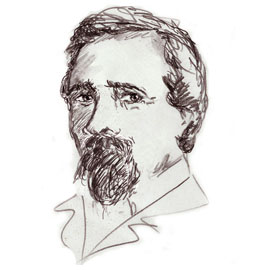Edward Bannister, an artist from birth, arrived in Boston in 1850 from his native Canada. As many young men from St. Andrew's, he "went to sea", working his way up to the position of cook. Perhaps his cuisine was enhanced by his boundless creativity! This crew position was lucrative, and also brought him into contact with the port cities of the eastern United States. His familiarity with these cities aided his move to Boston in 1850, seeking a chance to become a fine artist.
The Fugitive Slave Act of that same year added to the perilous conditions for a person of color. Opportunities for education were few. Bannister could not even visit an art museum. In Boston, Bannister became involved with the Abolitionist Movement. Creating jobs allowed the Abolitionist community to grow despite the restrictive laws. Bannister worked in a variety of these businesses, including barbering in the hair salon of Madame Carteaux. By 1857, Christiana Carteaux and Edward Bannister were married; both of them charismatic, creative activists. He credited her as his greatest believer, sharing her contacts in the Abolitionist Movement as well as her entrepreneurial success.
In 1863, only 35 years old, Edward Bannister was included in William Wells Brown book: The Black Man: His Antecedents, His Genius, and His Achievements.
"Mr. Bannister possesses genius...and he is daily gaining admirers of his talent and taste....It is indeed commendable in Mr. Bannister, that he has thus far overcome the many obstacles thrown in his way by his color, and made himself an honor to his race."
Bannister's natural talent became polished as he found the right teachers and encouragement by artists such as Francis Bicknell Carpenter, and by 1870, he was painting full time. Christiana and Edward moved to her native Rhode Island after the War. Their careers flourished...her salons attracted the finest clientele, and, in 1876, his monumental painting, Under the Oaks, won first prize at the Centennial Exposition in Philadelphia.
His paintings gained acclaim, and many more prizes followed. Bannister was a leader in the American art world, emerging out from the shadow of European culture.
In 1880, he and close colleagues George Whitaker and Charles Walter Stetson formed the Providence Art Club, to create a gathering place for artists and art lovers, a gallery to show their work, and a forum to discuss art. Still holding court in the same location on Thomas Street in Providence, the Art Club continues to present art with the same flare and passion as in Bannister's day.
Despite prejudice and bigotry, suffocating restrictions and endless prohibitions, Bannister became a fine painter; to this day, his work thrills the viewer with his deep spirituality and love of nature. In particular, his early years at sea influenced many of his finest works which depict a tumultuous sky and reflective waters.


